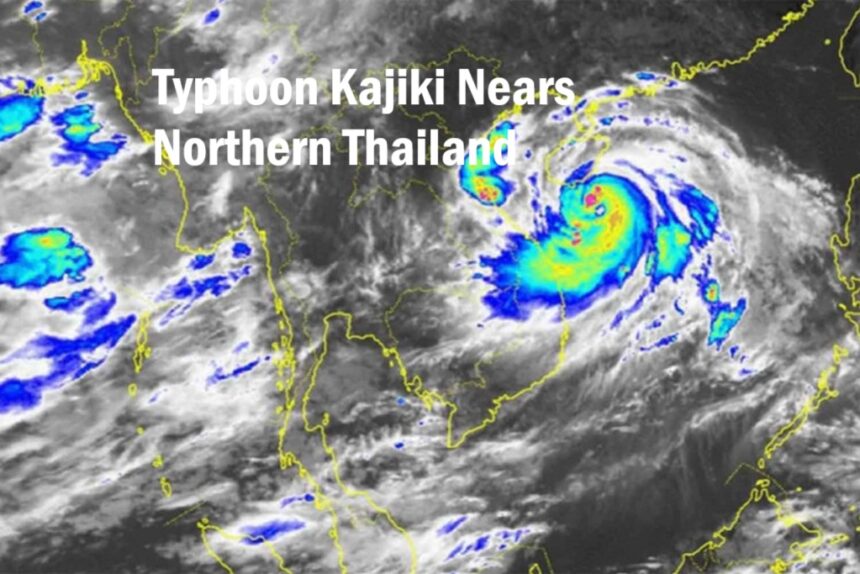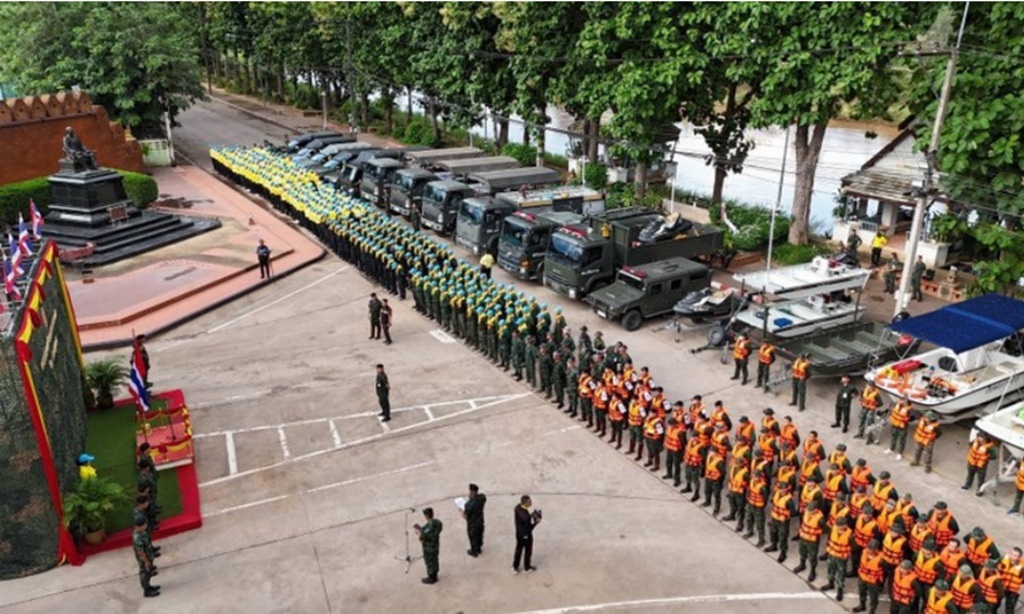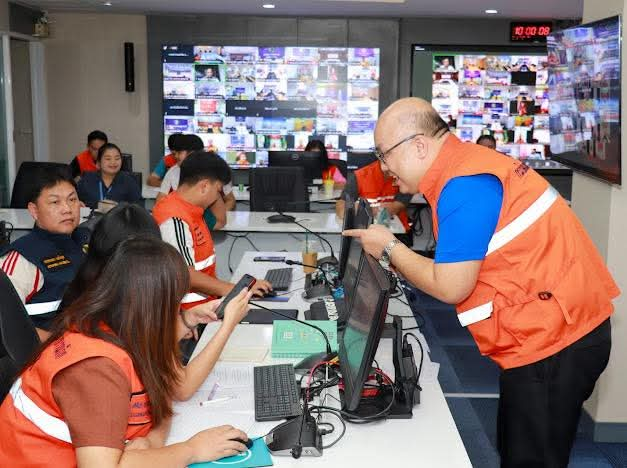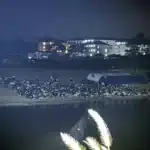CHIANG RAI – With Typhoon Kajiki drawing near northern Thailand, Nan province faces another bout of dangerous weather after recent floods. The Thai Meteorological Department has warned that Kajiki, the thirteenth tropical storm in the northwest Pacific this year.
Still, the storm’s effects are expected to be serious. Authorities have increased disaster alerts to the highest level. Nan and 15 other northern and northeastern provinces are preparing for heavy rainfall, flash floods, and landslides.
In Chiang Rai, the provincial governor has rolled out emergency plans, with the area on standby for a tough week ahead.
Nan Province: Bracing for Typhoon Kajiki
Nan is known for its green valleys and peaceful rivers, yet it’s no stranger to severe flooding. Earlier this year, tropical depression Wipha caused heavy floods, forcing more than 500 families from their homes across eight districts. Thawngpha district was hit hardest, with fast-rising rivers forcing residents to leave their belongings behind as they moved to safety.
With Typhoon Kajiki approaching, experts believe Nan’s risk will rise again. Assoc. Prof. Seree Supratid, Director of the Climate Change and Disaster Center at Rangsit University and Vice President at the National Disaster Warning Council Foundation, has named Nan as the province most at risk from Typhoon Kajiki. He predicts a one in ten chance of rainfall passing 500 millimetres, which could bring major flooding and severe flash floods.
The Thai Meteorological Department released its 11th warning at 4 am on Monday, 25 August 2025. At that time, Typhoon Kajiki was over the upper South China Sea about 200 kilometres southeast of Vinh City, Vietnam, with top winds of 150 km/h.
The storm is expected to cross into northern Vietnam on Tuesday before weakening into first a tropical storm and then a depression as it moves towards Laos. By Tuesday evening, the system should reach Nan as a strong low-pressure area, bringing heavy to extremely heavy rain.
Chiang Klang, Pua, Tha Wang Pha, Mueang, and Wiang Sa face high risks of flash floods and river overflow. The Nan and Yom river basins may reach dangerous levels, although storage capacity in some areas remains.
The Department of Disaster Prevention and Mitigation (DDPM) has issued warnings through Cell Broadcast, focusing on four districts in Nan. Residents there have been told to prepare for possible evacuation and move valuables to higher ground.
The warnings stress the risk from flash floods, runoff, and landslides. The storm’s peak is expected on the morning of Wednesday, 27 August. Local officials have set up “war rooms” for monitoring, evacuation planning, and emergency response, working with national disaster, water, mineral, and irrigation agencies.
Disaster Readiness at Maximum
Thailand has raised its disaster alert to the highest level as Typhoon Kajiki approaches. The National Disaster Warning Center is overseeing operations from a central “war room,” supporting high-risk provinces.
In Nan, teams are ready to respond fast and provide disaster relief, with local military, police, and government units standing by to help evacuate residents and deliver assistance. DDPM is sending out real-time safety warnings using Cell Broadcast and SMS, so people in at-risk zones get updates quickly.
True Corporation, a leading telecom provider, has reviewed its systems after the earlier impact of Typhoon Wipha to make sure it can support communities during Kajiki. The firm has prepared network teams and set up a 24-hour control centre at its Business and Network Intelligence Center, using AI to monitor mobile and internet networks.
In Nan, Chiang Rai, and Phrae, True has positioned emergency power supplies, including generators, fuel, and backup batteries, as well as mobile base units to keep phone signals strong in danger zones. The company has used scaffolding to raise equipment above floodwater and has teams with 4WD vehicles and boats on call for access to hard-hit areas.
In Chiang Rai province, Governor Putthipong Sirimart has put safety measures in place before the storm. While Nan is expected to take the greatest blow, Chiang Rai is also on the high-risk list as forecasts point to heavy rainfall and possible flash floods in areas such as Chiang Rai city, Lampang, and Phayao.
The Disaster Prevention and Mitigation Center in Region 15 is working with the military, police, and other agencies to make sure rapid-response teams are ready and relief supplies like food, water, and medical kits are available in case roads or bridges are cut off.
Officials have also worked to protect key infrastructure. Crews are improving drainage and clearing debris from streams and drains, hoping to stop urban flooding. Schools and public buildings are being readied as shelters.
People who live in low-lying areas have been asked to stay alert and be ready to leave quickly if evacuation orders come. The governor reminded everyone how important it is to follow official advice and steer clear of risky zones.
The North Holds Its Breath
As Typhoon Kajiki advances, much of northern and northeastern Thailand is preparing for difficult days. The meteorological office has announced that 35 provinces, including Bangkok, will get heavy rain over large areas.
Nan, Chiang Rai, and nearby provinces are at the highest risk. The storm is likely to bring strong winds and waves up to three metres high in both the upper Andaman Sea and the Gulf of Thailand, making sea and coastal activities more difficult.
The history of flooding in Nan means people there are not taking this storm lightly. The combination of torrential rain, flash floods, and landslides could threaten lives, homes, and property. Seree Supratid has urged everyone not to underestimate the risks and to keep safe by following evacuation advice and staying away from dangerous areas.
As Tuesday evening gets closer, focus is on Nan and its neighbours. Government officials, local leaders, and private companies like True Corporation have come together to try to reduce the storm’s impact and look after at-risk communities.
In Chiang Rai, the emergency plan reflects a strong effort to protect both lives and businesses. Even with these steps, the scale of Typhoon Kajiki is a reminder of how much more frequent and severe storms have become in recent years.
People in Nan and Chiang Rai are prepared yet anxious as they wait for the storm to make landfall. The next several days will reveal how well Thailand’s disaster planning works under pressure. The Chiang Rai Times will continue to share updates and reliable news to help keep everyone informed and safe.
If you witness or experience a disaster, you can report an incident and request assistance via the DDPM Line Official Account “DDPM Report 1784” by adding the Line ID @1784DDPM or via the 24-hour Emergency Hotline 1784 for further assistance coordination.

















